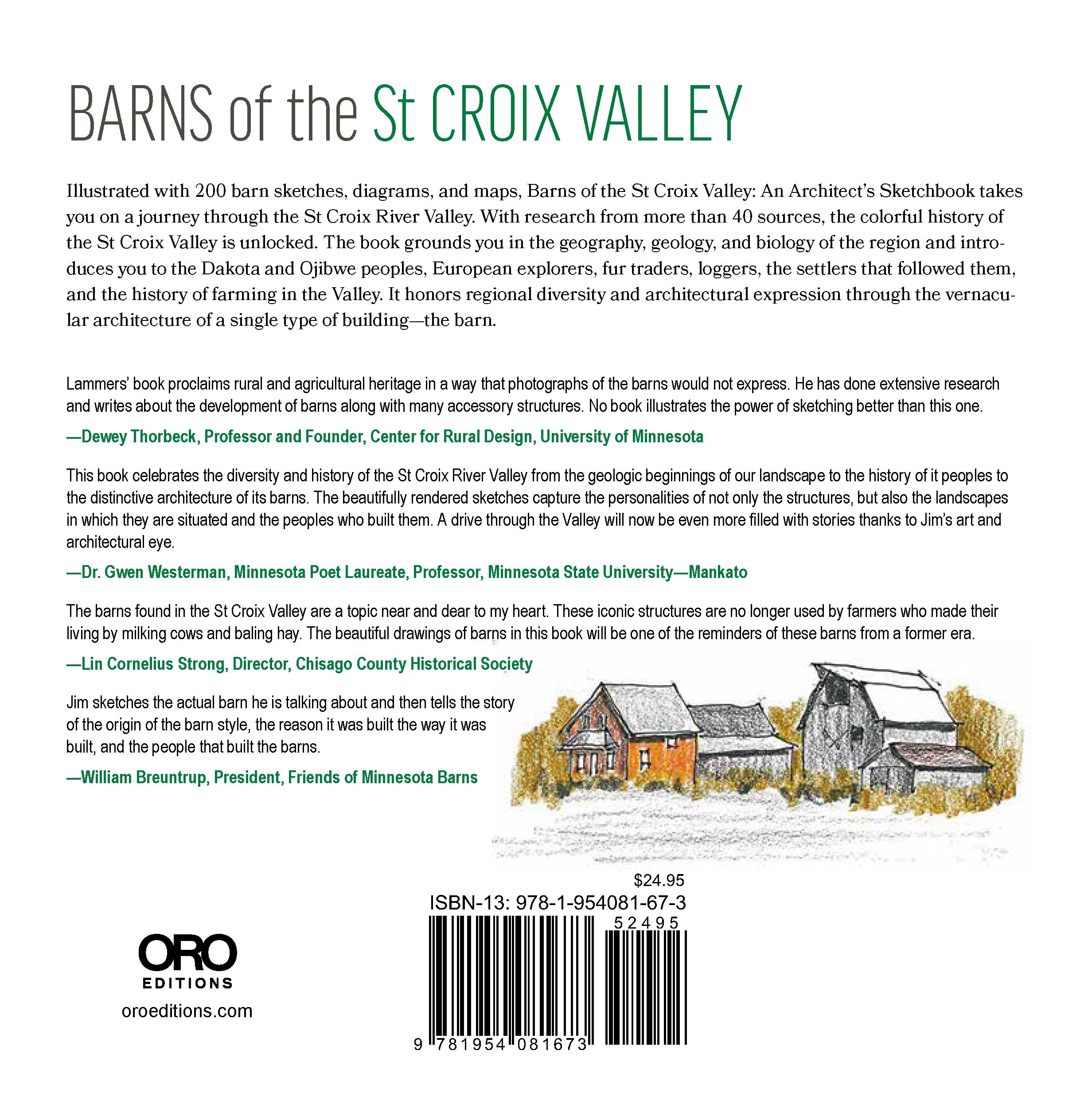
Author’s Note
Preface
Introduction
Map of the St. Croix Valley
The St Croix River
Map of the St Croix River Watershed
Map of Major Tributaries and Surrounding Counties
and Fauna
Wild and Scenic River
National Heritage Area
St Croix Valley
and Ojibwe Peoples
of European Intrusions
Showing Vegetation Change
vii Contents
. . . . . . . . . . . . . . . . . . . . . . . . . . . . . . . . . . . . . . . . . . . . . . . . . . . . . . . . . . . . . ix
. . . . . . . . . . . . . . . . . . . . . . . . . . . . . . . . . . . . . . . . . . . . . . . . . . . . . . . . . . . . . . . . . . xi
. . . . . . . . . . . . . . . . . . . . . . . . . . . . . . . . . . . . . . . . . . . . . . . . . . . . . . . . . . . . . . . 1
........................................... 2
. . . . . . . . . . . . . . . . . . . . . . . . . . . . . . . . . . . . . . . . . . . . . . . . . . . . . . . . . 3
.................................. 3
.................... 4 Geology ............................................................ 6 Flora
.................................................... 7
............................................... 8
............................................. 10
. . . . . . . . . . . . . . . . . . . . . . . . . . . . . . . . . . . . . . . . . . . . . . . . . . . . . . . . . . . . 11 Dakota
......................................... 12 Timeline
.................................... 15 European Explorers ................................................ 15 Fur Traders ....................................................... 18 Map
in the St Croix Valley ................ 19 Loggers ........................................................... 20 Logging Crew ..................................................... 25 Marine Lumber Company........................................... 25 Steamboats ....................................................... 26 Military Road ...................................................... 28 Railroads ......................................................... 29 Barn Builders . . . . . . . . . . . . . . . . . . . . . . . . . . . . . . . . . . . . . . . . . . . . . . . . . . . . . . . . . . . . 32
viii • BARNS OF THE ST. CROIX VALLEY Settlers ........................................................... 32 Swedes ........................................................... 34 Women’s Work .................................................... 39 Map of Transition Zone ............................................. 41 Pine Barrens ...................................................... 42 Barns of the Valley . . . . . . . . . . . . . . . . . . . . . . . . . . . . . . . . . . . . . . . . . . . . . . . . . . . . . . . . 45 Wheat Barn ....................................................... 45 Scandinavian Barn................................................. 48 Bank Barn ........................................................ 48 Basement Barn .................................................... 49 Barn Roofs ........................................................ 50 Saltbox ........................................................... 51 Gambrel .......................................................... 52 Gothic Arch ....................................................... 54 Fences ............................................................ 56 Farming Changes .................................................. 58 Round Barns ...................................................... 62 General Purpose Barns ............................................ 64 Other Barns ....................................................... 65 Livestock ......................................................... 69 New Barns ........................................................ 71 Barn Materials .................................................... 73 Big Changes . . . . . . . . . . . . . . . . . . . . . . . . . . . . . . . . . . . . . . . . . . . . . . . . . . . . . . . . . . . . . . 74 Technology Impacting Farming...................................... 75 Mechanical Revolution ............................................. 75 William Louden ................................................... 78 Rural Electrification ................................................ 79 Biotechnology and Agrichemicals .................................... 82 John Deere ........................................................ 84 Role of Government ................................................ 86
C ONTENTS • ix Barn Extensions . . . . . . . . . . . . . . . . . . . . . . . . . . . . . . . . . . . . . . . . . . . . . . . . . . . . . . . . . . 88 Silos ............................................................. 88 Ice Houses ........................................................ 92 Milk Houses ....................................................... 92 Red and White..................................................... 94 Windmills ......................................................... 95 Granaries ......................................................... 97 Corn Cribs ........................................................ 99 Grain Elevators ................................................... 101 Chicken Coops ................................................... 103 Root Cellars ...................................................... 104 Saving Barns . . . . . . . . . . . . . . . . . . . . . . . . . . . . . . . . . . . . . . . . . . . . . . . . . . . . . . . . . . . . 105 My Barn ......................................................... 108 Barn Quilts. . . . . . . . . . . . . . . . . . . . . . . . . . . . . . . . . . . . . . . . . . . . . . . . . . . . . . . 109 Farming Today . . . . . . . . . . . . . . . . . . . . . . . . . . . . . . . . . . . . . . . . . . . . . . . . . . . . . . . . . . 111 Family Farm ..................................................... 111 Agribusiness ..................................................... 112 A rcher-Daniels-Midland ........................................... 113 Environmental Impact ............................................. 114 Sustainability ..................................................... 115 Case Study ....................................................... 117 Technical Terms . . . . . . . . . . . . . . . . . . . . . . . . . . . . . . . . . . . . . . . . . . . . . . . . . . . . . . . . . 119 Appendix . . . . . . . . . . . . . . . . . . . . . . . . . . . . . . . . . . . . . . . . . . . . . . . . . . . . . . . . . . . . . . . . 127 Resources . . . . . . . . . . . . . . . . . . . . . . . . . . . . . . . . . . . . . . . . . . . . . . . . . . . . . . . . . . . . . . .134 Acknowledgements . . . . . . . . . . . . . . . . . . . . . . . . . . . . . . . . . . . . . . . . . . . . . . . . . . . . . . .138 About the Author . . . . . . . . . . . . . . . . . . . . . . . . . . . . . . . . . . . . . . . . . . . . . . . . . . . . . . . . . 140
Author’s Note
Locations are referenced to current towns and counties that did not exist in the early days .
x
Preface
Growing up at the edge of the prairie in a small, rural, northwestern Minnesota town, I always loved to sketch . A fter discovering the architectural profession and studying architecture at the University of Minnesota and Yale University, I won the Rome Prize in Architecture and headed to the American Academy in Rome . During my two years in Italy, I discovered rural hill towns that were so different from rural towns in the U .S . This discovery led to my founding the Center for Rural Design to bring design to rural issues the same as urban design dealt with urban issues .
The beautiful colored pencil sketches in Barns in the St. Croix Valley and accompanying descriptions illustrate how early settlers in the region brought with them their nationality and ethnic traditions for barn construction, shape, and function and interacted with the landscape of place to identify where they should build and how they would farm . Initially it was to provide food for themselves and families, and later, as rural communities developed, it opened the door to selling cream, meats, and crops that changed how they farmed and the buildings they constructed . Today, however, the small, diversified farm that was so prevalent until the 1960s has pretty much disappeared, as farms became larger and more specialized to deal with the changing economics and population increase .
Lammers is an architect and good friend who likes to sketch and has explored the region, where he lives on a farmstead with a beautiful old dairy barn, to record other barns and how they came to become what they are . His book celebrates the rural agricultural heritage of Minnesota and Wisconsin in a way that photographs of the barns would not express . He has done an extensive historical review and writes about the development of barns in the region along with many other accessory structures that were constructed . No book illustrates the power of sketching better than this one .
Dewey Thorbeck, FAIA, FAAR
Professor and Founder, Center for Rural Design College of Design University of Minnesota
Author of: Rural Design: A New Design Discipline (Routledge 2012, China 2020)
Architecture and Agriculture: A Rural Design Guide (Routledge 2017)
Agricultural Landscapes: Seeing Rural Through Design (Routledge 2019)
xi
Introduction
For 30 years I’ve driven by the barns of the St Croix River Valley, but I didn’t really see them until I started sketching . These barns stand as a testament to a bygone era . To the way farming used to be . To an age when land was currency—ticket to a livelihood .
Today, a few of these classic old barns have been upgraded or preserved and repurposed, some pro vide wedding venues or support retail sales . Others, like mine, have been maintained but used only for storage or an occasional barn dance or celebratory dinner . On working farms, old barns are put to use but not as originally intended, which was for storing hay in the haymow and cows or cattle and young stock and horses or mules below . Many return to earth, little by little, until one day the barn you’ve been motoring by is now flat, marked only by a silo .
This book takes you on a journey back in time .
Native Americans and their ancestors lived in the Valley for 10,000 years, European explorers came in the 1600s, fur traders followed them, and lumber barons arrived in the early 1800s . A lthough not all of these groups built barns, they all impacted barn building .
The story of the barns themselves is the story of migrants from New England and immigrants from Europe, all seeking land . It is the story of agriculture and how it changed in the hundred years from the mid-1800s to the mid-1900s .
1
VALLEY
Map of the St. Croix Valley
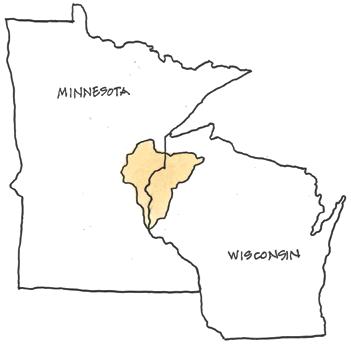
Good sized dairy barn near Holyoke, Minnesota, no longer in use. Owner was offended that I sat in the right-of-way and sketched the barn. She called the sheriff.
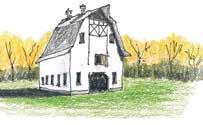
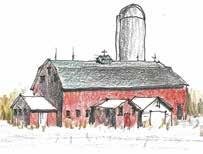
Gambrel-roofed dairy barn with three additions near Center City, Minnesota.
This Gothic arch dairy barn near Dresser, Wisconsin, is in the process of collapsing and the farm now specializes in Holsteins as beef cattle
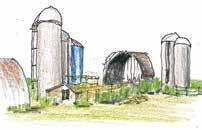
2 • BARNS OF THE ST. CROIX
The St Croix River
The St . Croix River takes its water from 18 counties—nine in Minnesota and nine in Wisconsin—before offering it to the Mississippi . Its watershed covers approximately 7,800 square miles, an area 50 percent larger than the state of Connecticut . The tributaries add up to 2,000 miles of waterways, more than the distance from the twin cities of Minneapolis and St . Paul to Miami, Florida .
Map of the St Croix River Watershed
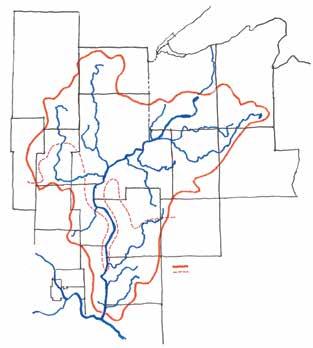
This barn north of Taylors Falls, Minnesota, with sheds both sides, has been around a long time.


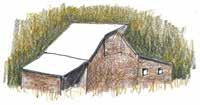
Source: United States G eological Survey.
Fancy dormers and lightning rods on this old a dairy barn south of Lindstrom, Minnesota.
Abandoned hopes near Ubet, Wisconsin.
T HE S T C ROIX R IV ER • 3
CROIX VALLEY
Map of Major Tributaries and Surrounding Counties
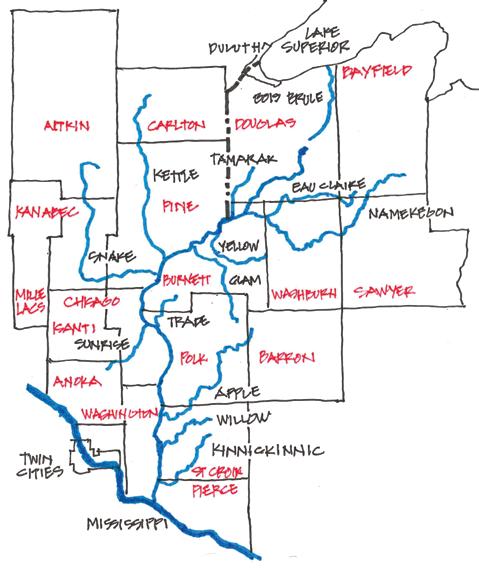
4 • BARNS OF THE ST.
The St . Croix River is easily divided into Upper and Lower on two counts: First, Taylors Falls was the head of navigation for steamboats and defined the northern reach of the Lower St Croix and the beginning of the Upper St Croix; and second, vegetation also demarks the Upper—coniferous forest—and Lower—decidu ous forest and prairie .
These old structures near Sunrise, Minnesota, are from the late 1800s; they represent a dream that’s dead.
Mid-1900s dairy barn with hay peak near Wolf Creek, Wisconsin, now retired. Likewise, a shed for feeding livestock.Near Marine on St Croix, Wisconsin, this old dairy barn features a basketball hoop and a barn quilt.
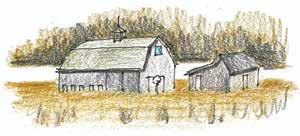
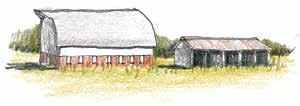

T HE S T C ROIX R IV ER • 5
Geology
A billion years ago, the tectonic plates shifted and shifted, and the lava spewed forth, congealing to become the extremely strong basalt we now know as trap rock . It towers over the St Croix River at the Dalles near Taylors Falls, Minnesota, and St Croix Falls, Wisconsin . But wait, there’s more . A great shallow sea washed over the Valley half a billion years ago, laying down layers of sand which formed the sandstone bluffs we see along the river today .
One more determinant—as the earth’s orbit and inclination bounced erratically a couple million years ago, the earth got colder and colder . Snow fell and fell and didn’t melt . Mile-thick glaciers advanced and retreated across the Valley, and as they did so, they sucked water from the sea .
I love this barn with a cupola that gives it the appearance of a church. Located near Stark, Minnesota.
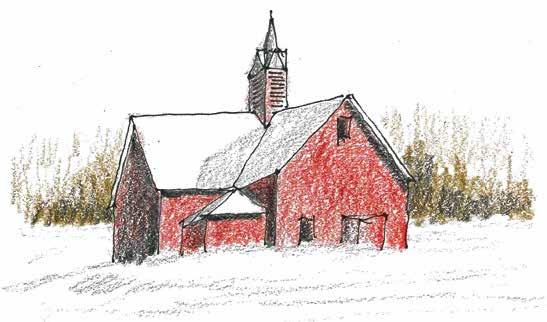
6 • BARNS OF THE ST. CROIX VALLEY
The last of the glaciers, the Wisconsin, started melting about 20,000 years ago . A s the glacier retreated, sculpting the land and depositing the fieldstone which would be used for barns, the meltwater ran to the sea . Then the glacial lake we call Duluth—after the French explorer Daniel Greysolon Sieur Dulhut—overflowed, shaping the entire Valley and leaving the present Lake Superior .
Glaciers are evidenced by deposits of till, moraines, drumlins, eskers, and erratics . On the Minnesota side of Interstate State Park, which occupies both sides of the St Croix River below Taylors Falls, geologic potholes were drilled by boulders into the sandstone in the eddies of the floodwaters—some as deep as 60 feet . In Agriculture in Minnesota, Edward Robinson says:
Prior to the ice invasions the valleys were generally deeper, the surface more rolling and more thoroughly drained than is now the case.
As a result of the ice incursions, the soil of the Valley is almost totally glacial . In his book The Earth Brought Forth, Merrill Jarchow writes:
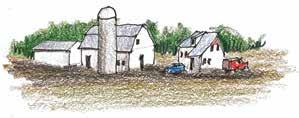
This means that the chemical composition is so varied, the rock contents being derived from every neighboring rock formation, that the soil is fertile for every kind of crop.…”
This barn in Chisago County has an adjacent greenhouse with poly roof, but just one rooftop ventilator.
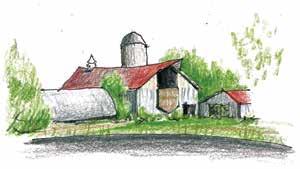
T HE S T C ROIX R IV ER • 7
Old dairy operation now just a homestead north of St Croix Falls.
A hansom brick barn near Wolf Creek, Wisconsin. No longer in use, it enhances the landscape with granary and sheds .
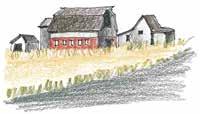
Flora and Fauna
As the earth warmed and the ice sheets melted, vegetation spread north . Seeds that were long dormant sprouted while others were blown in or carried in by migrating wildlife . The sandy soil of the Upper St Croix Valley supported a Canadian boreal forest of conifers—spruce, fir, pine, tamarack or larch, as well as broadleaf or deciduous trees—birch and popple or poplar . In The Earth Brought Forth, Jarchow writes:
Eighty-one species of forest trees and about 125 species of shrubs are indigenous … and about 125 species of native grass and numerous varieties of wildflowers are to be found.
After logging harvested the white pine in the Upper St Croix, jack pine—whose tight-fisted cones release seeds only after a fire— birch and poplar took over; one popple tree alone produces a mil lion seeds . First thought useless, the poplar found a purpose as pulpwood for papermills . A n oak-hickory forest containing sugar maple, flowering dogwood, and blueberry prevailed .
This 1800s granary is at the Amador Heritage Center in Almelund, Minnesota.
Bison, elk, and wildcats were abundant but now long gone . Sturgeon once plentiful but now rare . R attlesnakes once profuse no longer common . Passenger pigeons extinct . Other animals— black bear and white-tail deer, raccoons, opossum, beaver, muskrat, gophers, squirrels, chipmunks we see today . Birds— great blue herons, wild turkeys, eagles, hawks, geese, ducks, woodpeckers, blue jays, cardinals grace us with their presence . Fish—walleye, northern pike, trout, small and large mouth bass, crappie, muskie, sauger, catfish, bluegill, and, unfortunately, carp attract anglers .
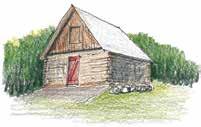
8 • BARNS OF THE ST. CROIX VALLEY
Wild and Scenic River
The St Croix River’s designation as a Wild and Scenic River was spawned in 1964 by Northern States Power (NSP, now Xcel Energy) which planned to construct the Allen King coal-fired generating plant on the river in Oak Park Heights, Minnesota . Residents along the river rose up to form ‘Save the St Croix,’ which unsuccessfully opposed the plant but evolved into today’s Wild Rivers Conservancy of the St . Croix and Namekagon . NSP’s earlier plan had been to build a series of dams along the Upper St Croix on the 30,000 acres it had acquired in the early 1900s on both sides of the river, extending 70 miles north of St Croix Falls .
Thankfully, this plan fell through .
The proposed King Plant caught the eye of Wisconsin senator Gaylord Nelson, chair of the Senate’s Air and Water Pollution Subcommittee . Nelson, former governor of Wisconsin and an environmentalist who later launched Earth Day, opposed the plant and drafted a bill to make the St Croix a National Scenic Waterway . But in the end, he capitulated, striking a deal whereby NSP would donate its Upper St Croix land holdings for public use in exchange for Nelson’s support for the King plant .
Augmented by NSP’s holdings, many public lands now adjoin the St Croix and its tributaries . These range from city, county, and state parks and park preserves to wildlife management areas and state forests . Camping grounds, hiking trails, and put-in land ings abound .
The National Wild and Scenic Rivers Act became law in 1968, but included only the Upper St Croix River from Taylors Falls upstream and its major tributary, the Namekagon, as ‘scenic .’ The Lower St Croix River was added in 1972 as ‘recreational .’ Minnesota Senator Walter Mondale called it, “the last remaining unpolluted, scenic river in the country next to a major metropoli tan area . ”
The historic 1931 lift bridge that crosses the St Croix River at Stillwater, Minnesota, is now for pedestrians only, replaced by the new bridge downstream.
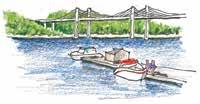
This good looking extradosed bridge over the St Croix River south of Stillwater was completed in 2017 after federal legislation granted exemption to the Wild and Scenic Rivers Act.

T HE S T C ROIX R IV ER • 9
Barn and granary from the 1800s are preserved at the Amador Heritage Center in Almelund, Minnesota.

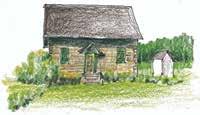
National Heritage Area
In 2008, several members of the St Croix Valley Foundation Board took an interest in making the St Croix Valley, as defined by the St Croix River’s catchment area, a National Heritage Area . In 2021, the National Park Service, which oversees the National Heritage Area Program, approved the 2014 feasibility study for the ‘North Woods and Waters of the St Croix National Heritage Area .’ This designation, which still requires an act of congress before it is official, will help protect and improve the area’s nat ural, cultural, and historic resources, and it will boost tourism .
There are 55 designated National Heritage Areas across the country—the ‘North Woods and Waters of the St Croix National Heritage Area’ will become number 56 .
Settlers’ cabin preserved at the Amador Heritage Center in Almelund.
10 • BARNS OF THE ST. CROIX VALLEY
St Croix Valley
Before the barn builders came into the Valley, Native Americans—Dakota and Ojibwe—were here, leaving their mark for hundreds of generations . Then came the European explorers who often became fur traders . Loggers paved the way for the set tlers by making land and material available for barn building .
Gable-ended barn with lightning rods and shed near McKinley, Wisconsin. The owner has just purchased and plans to fix it up. Good luck.
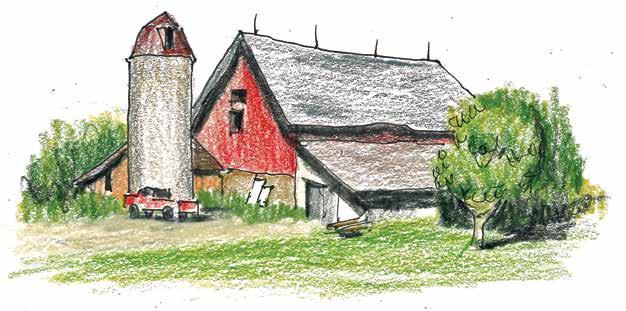
S T C ROIX V ALLEY • 11
Livestock
Where did the animals come from? They weren’t in the Valley when the pioneers got there . There are several livestock breeds, but here are some of the most common .
Let’s look at popular dairy breeds and origins . Holstein, some times called Holstein-Friesian, were imported by New York’s Dutch settlers in the 1850s . They originated about 2,000 years ago . Black animals from the Batavians, which is in present-day Germany, and white animals from the Friesians, which is in pres ent-day Holland, were crossed to create a new breed . The most popular dairy breed, these large, showy, black and white spotted cows are also the best milk producers by far . Similar, but showier, is the Dutch Belted, or Oreo Cow, with a white stripe around its middle, first imported from, of course, Holland in 1838 .
My great, great-grandfather, Lammert Hinrich Claassen, was born in 1726 in Osterfriesland, a province of what was then Prussia, once Holland, and now northwestern Germany. So, my ancestors on my father’s side were Friesians same as the cattle. Small world.
The small, gentle, fawn-colored Jersey from the British Channel Island of Jersey just off the coast of France gives the richest milk . They were imported in the 1740s and 1950s . The tan and white Guernsey from another Channel Island of Guernsey were first imported in 1878 .
The larger, similarly colored Brown Swiss, imported from—you guessed it—Switzerland in the late 1800s, is the second-best milk producer .
Leo Schiltgen raised purebred HolsteinFriesian dairy cattle at his North Star Farm on Stillwater Boulevard in Lake Elmo, Minnesota. The farm is now, unfortunately, scheduled for demolition. How sad.

B ARNS OF THE V AL LEY • 69
VALLEY
A 1909 once-was barn in Polk County on a farm that used to milk Holsteins but now raises them for beef.
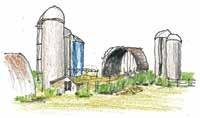
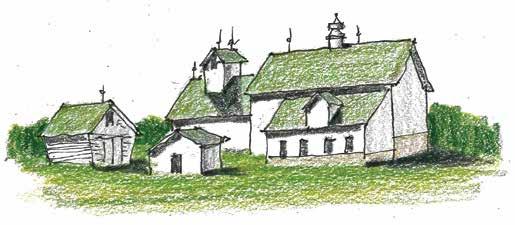
Black Angus, the big name in beef cattle, were imported from Scotland in 1873 . W hite-Face Hereford is a popular English breed imported in 1847 . A ngus are sometimes bred with Herefords, producing Black Baldies . A Scottish type seen around is the mop-top Highland, not imported until 1922 . Shorthorns, or Durhams, with their brown or brown with dappled white coloring, came from Durham County in northeast England in 1873 . They were, and still are, popular, and they could be used for milking or beef production .
A popular horse breed early on was the Morgan, originating in Massachusetts in 1879 and used to pull farm equipment . Later, two other breeds became popular: Clydesdales, brought from Lanarkshire, Scotland, near the River Clyde in 1842, and Percherons from western France in 1839 . Horses were found to be much better than oxen for pulling farm equipment . Mules were also used because they have excellent hooves and stoic sensibility . However, horses are stronger than either oxen or mules .
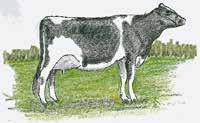
70 • BARNS OF THE ST. CROIX
This exquisite array of white buildings is part of the Schiltgen farm south of Stillwater Boulevard in Lake Elmo.
The mighty Holstein-Friesian.
New Barns
Of course, the old barns we love—gable, gambrel, or gothic arch roofs, two-story with haymows—aren’t built anymore . New barns respond to new functions: no need for a haymow, so milking can be done in a one-story building; and for row crops, there is no need for a barn at all . In fact, not only are these barns biting the dust, but even the name barn is disappearing, to be replaced by the term general utility building .
Steel buildings became standard during and after World War II . Quonset huts with their rainbow rooflines were developed for the war, and afterward factories had plenty of capacity—selling to farmers presented a good market . Farmers could order the prefabricated pieces and bolt them together themselves .
Pole barns had been developed in the 1930s but not patented until 1953 . These gable-ended, steel-clad buildings used creosote treated poles, 2 by 4 framing, and pre-painted sheet metal roofing and siding . They were relatively inexpensive and easy for farm ers to build themselves . Dirt floors could later be covered with concrete .
Quonset type shelter near Scandia houses a tractor and wagon.

Quonset type bank barn with silo out by its lonesome in a hayfield in Washington County. Apparently other buildings survived.
Quonset barn, perhaps used as a granary or machine shed near Scandia.
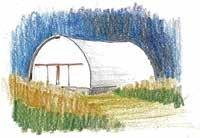
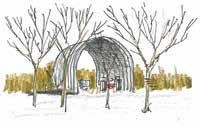
B ARNS OF THE V AL LEY • 71
CROIX VALLEY
A step up from pole barns, serious steel buildings are well engi neered, larger scale, supported by light-gage open-web steel bents (remember the heavy timber bents of the early threshing barns?) . They use long span, pre-painted steel roof deck, vertical prepainted steel siding, concrete slab-on-grade, and footings or piles extended below frost line .
Section through a steel building.

The big barn is gone; a Quonset hut building peeks out on the left, and perhaps a repurposed claiming shanty on the right.

72 • BARNS OF THE ST.
ST. CROIX VALLEY
Agriculture, says the tractor “was and remains … the centerpiece of mechanization on American farms .” Wayne Rasmussen, USDA historian, notes:
One of the interesting sidelights of such history is the time lag between an invention and its adoption. In fact, I have come to the conclusion that the major changes in American agriculture have taken place only when farmers have had major economic incentives for adopting such changes … Adoption of the new, laborsaving machinery sped up in times of high commodity prices and during labor shortages.
Farmers themselves contributed innovation, adaptation, and ingenuity as they struggled to keep their equipment and buildings functioning and functional—always looking for an easier way to farm . Farm machinery moved from wood and cast-iron to steel and welded assemblies, with bearings, gears, and high-speed shafts . By 1912 there were 50,000 farm implement dealerships in the United States . Cochrane says, “advances came so fast … and reduced human labor require ments as to constitute a mechanical revolution in farming .” A .N . Johnson writes in Agricultural History 24:
By 1950 a fair minimum of equipment for an average Midwest farm included a tractor, plow, disc cultivator, drag, grain drill, corn planter, manure spreader, milking machine,
hay loader, silage cutter, and cream separator.
As an indicator of the production curve, growing 100 bushels of wheat in 1830 took 300 hours of labor; in 1890, 50 hours; in 1930, 20 hours; and by 1975, just 3 hours . A s production increased, profits grew, as did farm size .
The number of farm workers plunged, “freeing or forcing hordes of farm youth to seek city jobs . Redundant or abandoned farmsteads were one of the results,” according to John Hart in The Rural Landscape. Cochrane says:
The rate at which labor was displaced in agricultural production by machines … certainly worked a great hardship on many of the people involved and created acute problems for the urban areas that received the rural migrants.
Although more money went into farm equipment than farm buildings, the new machinery resulted in new types of structures and alterations to exist ing barns—fewer barns for mules and horses, more implement sheds, garages, workshops, silos, larger haymows or one-story barns, fewer corncribs but more grain bins .
As tractors replaced horses and mules, the acreage that had been used for their feed became available . At the same time, the high cost of farm implements forced farmers to use their machin ery more efficiently in order to amortize the cost . Often neighboring farmers would share one piece of equipment . I believe this led to farming more
76 • BARNS OF THE
land, because it was only with additional produc tion that cash could be generated to pay for the equipment . The 160-acre farm was “somewhat inadequate in respect to the efficient use of labor and machinery,” according to William Cavert writing in Minnesota Farmers’ Institutes Annual 39 . Hart says:
Machinery and other advances changed agriculture from a low-volume enterprise with good profits per unit to huge volumes with minuscule per-unit profits.
The effect of mechanization was dramatized in the Cutover area of the Upper St Croix Valley, where most farmers were into dairy, potatoes, and pigs, with pastureland for the cows . They sold cream and butter, feeding skim milk to the hogs . Manure was used to fertilize potatoes .
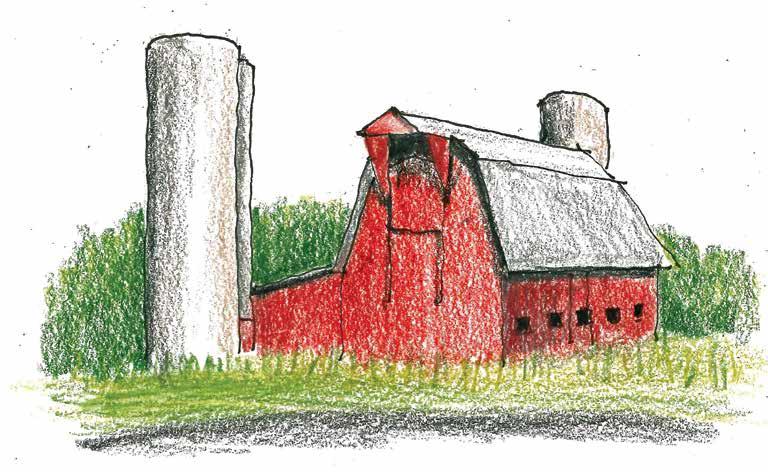
Nothing was spent on fertilizer, herbicides, or pes ticides except maybe arsenic for potato beetles . In the 1940s, mechanization, commercial fertilizers, and pesticides for potato diseases increased pro duction, but the Cutover farms couldn’t compete with the larger, more specialized Red River Valley farms . At the same time, since whole milk was being picked up farm to farm, there was no skim milk for the pigs . Farmers focused exclusively on dairy; milk houses were added, hog barns, corncribs, and potato warehouses were converted or fell into disrepair .
Mechanization brought more financial risks, and farms became highly capitalized, spending money not only on equipment but on equipment repair, hybrid seeds, fertilizers, and chemicals . More
productivity was a constant goal . Large, special ized farms required good management and in Hart’s words,
Farming changed from a way of life to a complex business that demanded a wide range of management skills, including the skill of money management. Modern farmers must be able to handle large amounts of money just as competently and efficiently as they handle powerful tractors and other large farm machines.
The mechanical revolution eventually produced chronic surpluses which pushed prices down . This, of course, led to more production which forced prices even lower . Expenses rose as prices fell . Government then stepped in and encouraged farmers to curb production .
However, farm life improved . According to one writer, machinery transformed farming from “long hours of drudgery to less arduous effort, yielding more time to enjoy good living in mod ern buildings equipped with modern conve niences .” In 1957, the Farm Equipment Institute proclaimed, “High production per man, with labor-saving, cost-cutting equipment, has brought a better way of life for all . It has made America a Land of Plenty .” This might be over-the-top hype, but without a doubt farming transformed from a family endeavor to a full-fledged business .
B IG C HANGES • 77
What about Mary Ann? She’d grown up on a dairy farm north of Scandia and pitched in helping with everything except milking . She raised six kids and eventually began working in the Post Office as a ‘part-time flexible’ and later as a mail clerk for 20 years—health insurance and a pension .
A couple five-acre lots have been sold off . Not long ago they sold the farm to their daughter and son-in-law, who winter in Arizona and will spend summers on the farm . Mary Ann and Dick retain a life estate in their old farm .
Would they do it again? Yes, just like Moberg’s character, Karl Oskar Nilsson . In spite of battling weather and prices, Dick enjoyed the freedom of being master of his own destiny and work ing in a noble profession .
Dick and Mary Ann’s barn shows off a barn quilt. It’s now being repurposed.
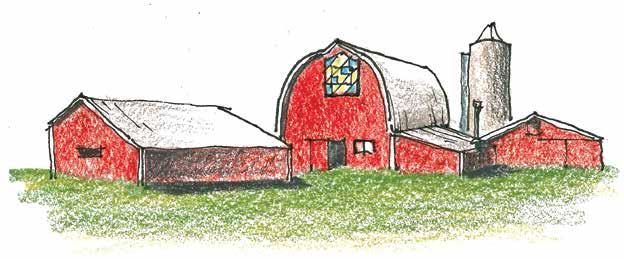
118 • BARNS OF THE ST. CROIX VALLEY
Technical Terms
Barge board: trim which runs along the edge of the roof at the gable end .
AAgribusiness: agriculture conducted on commercial principles, especially using advanced technology, or group of industries dealing with agricultural produce and services required in farming . Three components: agricultural input sector, production sector, and pro cessing-manufacturing sector .
Alfalfa: cool-season perennial legume commonly grown for feeding livestock or as a cover crop and soil conditioner .
Anhydrous ammonia: liquid used as a nitrogen fertilizer .
B
Bag silo: means of storing silage in air-tight bags
Balloon frame: ty pe of framing using dimension lumber studs extending from sill plate to cap plate .
Intermediate floors frame directly into studs as opposed to platform framing .
Bank barn: built into hillside .
Barn Shingles: asphalt roofing shingles which inter lock to prevent uplift .
Basilica plan: large nave flanked by side aisle on each side . Used for Roman meeting halls, Christian churches, and barns in Europe and North America .
Bay: in post and beam construction defined by space between two posts .
Beam: structural member spanning horizontally between two columns or between bearing walls .

Bearing wall: a masonry or stud wall carrying load of floor or roof above .
Beartrap Gate: dam spillway gate with two leaves . Solid upper stream leaf is kept in place by buoyant lower leaf until water is released to lower pool .
Bent: heavy timber posts on either side of barn con nected by beams and braces, or rigid steel frame
Board Foot: volume of wood contained in an area 12 inches x 12 inches x 1 inch, or 144 cubic inches .
119
THE ST. CROIX VALLEY
Boreal Forest: forest that grows in cold temperature regions with mostly cold-tolerant coniferous trees such as pine, spruce, poplar, birch, aspen, and fir .
Board and Batten: ver tical board siding with battens covering the space between boards
Boom: barrier placed in a river, designed to collect and or contain floating logs .
Boreal Forest: forest that grows in cold temperature regions with mostly coniferous trees .
Box girder bridge: main beams are girders in the shape of a hollow box, usually prestressed concrete .
Broadleaf: tree with flat leaves as opposed to conifers which have needles
Bunker or Bunk: bin containing feed for cattle .
Bunker silo: silage stored on the ground in pits, with or without concrete walls .
Burlap: Coarse fabric made from jute used for bags .
C
Cable-stayed: towers or pylons with cables which sup port the bridge deck .
Cantilever: beam that extends beyond its support (think of a diving board) .
Chaff: outer layer that is separated from grains such as wheat, before they are used as food .
Clerestory: windows located in a raised portion of roof clear of adjacent roof admitting light into a building .
Colter: ver tical cutting blade in front of plow share .
Column or post: ver tical structural member which carries load to foundation .
Come-along: hand-operated winch with a ratchet used to pull objects .
Conifer: evergreen trees and shrubs with needle-like leaves and seed-bearing cones .
Cord: volume of stacked wood 4 x 4 x 8 feet, or 128 cubic feet .
Cradle: scythe with basket for catching cuttings .
Crib: small building with slatted sides used for drying and storing crops .
Cribbing: stacked boards laid flat with broad sur face down .
Cupola: structure on ridge line of roof with windows or louvers to allow ventilation .
Cure: preserving by drying, salting, or smoking .
D
Dalles: the rapids in a river confined between walls of a canyon or gorge .
Dimension lumber: lumber cut to standard sizes
Draft: distance between a boat’s keel and the waterline
Drumlin: elongated hill in the shape of an inverted spoon or half-buried egg formed by glacial action
E
Ecosystem: community of living things, plus soil and water that supports it, interacting as a system .
Elevator: machine with endless belt for raising grain to a higher level .
English or Yankee barn: three-bay barn with side entrance(s) .
Ensile: preserving fodder by storing it in a silo .
Esker: long ridge of gravel and other sediment deposited by meltwater from a retreating glacier .
120 • BARNS OF
Extradosed: structure that combines the main elements of both a prestressed box girder bridge and a cable-stayed bridge .
F
Fanning Mill: simple screen, fan, and slatted canvas that mechanizes the winnowing process separat ing grain from lighter chaff and straw with a breeze created by a hand-cranked fan blowing grain and chaff across vibrating screens .
Finished lumber: lumber cut to standard sizes .
Flail: a hand threshing implement consisting of a wooden handle at the end of which a stouter and shorter stick is so hung as to swing freely; to strike with, or as if with, a flail .
Fodder: feed for livestock, consisting of hay, straw, or silage .
G
Gable roof: profile shaped like an inverted V .



Galvanized steel: steel coated with zinc to prevent rusting Gambrel roof: also called a Dutch roof, is a profile with two pitches, coming from the word for the hock or hind leg of a horse, which is roughly the same shape as half the profile of the roof

Girt: horizontal structural member spanning between studs or columns used for fastening vertical siding
Glacial erratic: glacially-deposited rock differing from the size and type of rock native to the area in which it rests .
Glacial till: sediment from erosion and entrainment of material by a glacier .
GMO: genetically modified organism whose genome has been engineered in the laboratory .
Gothic arch roof: each side of the roof rises in a curve to a ridge beam .
Grain: small, hard, dry, edible seed from grass including rice, wheat, barley, sorghum, and millet .
Granary: storehouse for thrashed grain .
H
Half-hip roof: hip roof which converts to gable partway to the ridge .


Half-monitor roof: roof shaped like a saw tooth with clerestory windows .
Hay carrier: see hayfork .
Hay Hood or Pentice: roof over cantilevered ridge beam offering protection from rain for pully and hayfork moving hay up to haymow .
Haymow: part of a barn where hay is stored, usually the upper story .
Hay rick: pile of hay or haystack .
Hay: stems, leaves, and seed heads of plants such as grass, clover, and alfalfa fed to livestock .
Hayfork : a grappling device connected to a track running along the ridge beam in the haymow pulled by horses used to distribute hay .
T ECHNICAL T ERMS • 121
CROIX VALLEY
Head of water: height of water behind a dam .
Heavy-timber construction: system with structural members at least 8 by 8 .
Hex signs: st ylized stars within circles or similar designs painted on barns .
Hip roof: roof with both the ends and sides inclined .



Hog Cots: por table structures for mother pig and young litter; also called colony houses .
Lime: calcium oxide produced by heating limestone . Used to treat soil or water to reduce acidity and improve fertility
Linseed oil: also known as flaxseed oil or flax oil from flax seeds . Drying oil—polymerizes into solid form .
Log Boom: barrier placed in a river to collect and/or contain floating logs .
Louver: set of angled slats fixed at regular intervals to allow air or light to pass through but to impede rain .
M
IImmigrate: to come to live permanently in a foreign country
Mansard roof: roof that encompasses an entire story usually with dormer windows .
JJerkinhead roof: upper portion of hip slopes back to the ridge, forming a partial hip .
Joist: horizontal structural members supporting a floor or ceiling .
Johnboat: narrow flat-bottomed square-ended boat used on inland waterways .
Jute: fiber extracted from the bark of the white jute plant .
K
Knee brace: diagonal structural member connecting vertical to horizontal and stiffening the structure with triangulation .
L
LED: light-emitting diode which glows when a voltage is applied .
Levee: embankment constructed to contain river flow
Midden: old dump for domestic waste which may include shells, fragments of pottery, and other arti facts associated with past human occupation .
Migrate: to move from one region to another .
Military Road: road built by the military for the protec tion of the frontier .
Milk House: small structure used expressly for the purpose of isolating fresh milk from the smells, dust, and microbes of the barn environment
Monitor: cupola running the length of a roof .
Moraine: mass of rocks and sediment carried down and deposited by a glacier .
Mortise: slot or opening cut in a timber to receive the tenon of another timber .
Mow: see haymow .
N
New England barn: barn plan with entrance on gable end .
Nogging: any material used to fill space between studs in an exterior wall .
122 • BARNS OF THE ST.
OOvershot water wheel: wheel where water is delivered through a trough and dropped onto the paddles .
Ox: castrated bull used as a draft animal .
P
Parging: coating a masonry wall with mortar .
PCB’s: polychlorinated biphenyls used in electrical transformers and other products .
Pentice: see hay hood .
Pilaster: a column which is engaged in a wall for addi tional support .
Pinery: forest or grove of pine trees .
Pleistocene: geological epoch that lasted from about 2,500,000 to 12,000 years ago .
Plow: farming implement with one or more blades fixed in a frame, drawn by a tractor or by animals and used for cutting furrows in soil and turning it over, especially to prepare for planting of seeds .
Plowshare: main cutting blade behind colter .
Pole barn: building supported by poles set in the ground .
Post and beam construction: structural system made up primarily of vertical and horizontal members . Post: see column .
Potash: alkaline potassium compound, especially potassium carbonate or hydroxide, found in rock deposits or made by soaking ashes in water, hence the name from which potassium is derived .
Poultry Netting: mesh of wire commonly used to fence in chickens made of thin, flexible, galvanized steel wire with hexagonal gaps also known as chicken wire
Preservation: act of safeguarding something .
Purlin: horizontal beam along the length of a roof or wall resting on main rafters or attached to columns .
Q
Quonset hut: lightweight prefabricated structure of corrugated galvanized steel that is semi cylindrical in cross-section .
R
Rafter: structural member supporting a roof by span ning from bearing wall or beam to ridge beam .

Recollet: member of a reformed branch of the Franciscan order founded in France in the late 16th century .
Rehabilitation: act of restoring to former condition .
Restoration: act of returning to former condition Ridge beam, ridge piece, ridge pole: horizontal mem ber at the roof peak separating roof rafters .
Rough-sawn lumber: lumber cut to size but not planed down to finished size .
S
Salt box roof: two -story gable-roofed barn with roof extending in back down to one-story; also called cat slide roof
Savanna: vegetation type that grows under open tree canopy (i .e ., scattered trees) above a continuous tall grass understory .
Shakes: wood roofing that is split on one or both sides .
Sheathing: outside covering on a wood framed wall or roof adding strength and providing underlayment for siding or roofing .
Shed Roof: roof sloping in one direction .
T ECHNICAL T ERMS • 123
VALLEY
Shiplap: boards fitted together so that each overlaps the one next to it .
Silage: chopped fodder stored airtight .
Sill plate: horizontal wood member laid on foundation to support studs or columns .


Silo: round tower-like structure for storing silage or grain .
Slaked Lime: soft, white, crystalline, very slightly water-soluble powder, Ca(OH)2, obtained by the action of water on lime . Used chiefly in mortars, plasters, and cements .
Sluice gate: sliding gate for controlling the flow of water in a dam .
Stanchion: a frame that holds the head of a cow in place for milking
Straw: stems and leaves of mature plants such as wheat, oats, or barley with seed heads harvested; it has very little nutritional value and is used as animal bedding .
Steer or bullock: young, castrated bull raised for beef . Stock Tank: large tank containing water for cattle (not a poor performing stock on Wall Street)
Sutler or Victualer: civilian merchant who sells provi sions to an army in the field, in camp, or in quarters .
Threshold: board placed on floor below doors, orig inally used to keep grain from escaping the thresh ing floor
Tie Beam: horizontal member in tension connecting two posts supporting roof to keep them from moving outward due to roof load .
Tie stanchion: means of holding a cow in place for milking, consisting of a chain attached to the head wall and looped over the cow’s neck and secured .
Tilted false-plate roof: roof that flairs out at the top plate of a supporting wall to create drip line away from the wall .

Timber-frame construction: see heavy timber construction Tithe barn: large warehouse built during the Middle Ages to house the tithe, a ten percent levy on harvests charged by the church .
Tongue-and-groove: boards fitted together by tongue (ridge) on one fitting into groove on next Trundle: solid wood wheel used on ox carts or wagons .
Truss: triangulated framework supporting horizontal loads .


U
Undershot water wheel: wheel where paddles are placed into the flow of a stream .
V
TTenon: formed end of a structural member which fits into a hole cut into the corresponding member
Thrashing: process of loosening the edible part of grain (or other crop) from the straw to which it is attached .
Ventilator: cupola fixed to roof ridgeline, allowing warm air to escape into the atmosphere .
Vernacular architecture: architectural style that is designed based on local needs, availability of construc tion materials, reflecting local traditions, and employ ing details unique to a particular region .
124 • BARNS OF THE ST. CROIX
Voyageurs: independent contractors, workers, or minor partners in companies involved in the fur trade licensed to transport goods to trading posts and usu ally forbidden to do any trading of their own .
W
Wallow: roll about or lie relaxed in mud or water, espe cially to keep cool or avoid biting insects
Wattle and daub: wall construction using small sticks chinked with mud or clay .
White lead: paint made by mixing lead carbonite and lead hydroxide
Whitewash: paint made from lime and water produc ing calcium hydroxide (slaked lime) .
Windmill: circular fan on a tower used to pump water and/or provide electricity .
Windshake: crack between the annual rings in wood caused by strong winds bending the tree trunk .
Winnow: to blow a current of air through grain in order to remove the chaff and straw .
T ECHNICAL T ERMS • 125
About the Author

Barns are everywhere in my life . I live on a 100-year-old farm stead with a huge red barn that I’ve been preserving over the past 30 years . My roots in Chisago County go back three generations . I drive by barns every day . I’m a traveler and travel sketcher—when Covid-19 put us all in lockdown in the spring of 2020, I began sketching the barns around me and realized what a treasure they are .
I was trained as an architect back when freehand sketching was an integral part of the curriculum, and I hold degrees in archi tecture from Iowa State University and Columbia University . My writing has been published in professional journals and online, and my drawings have been exhibited at various fine art venues . My book, Capture the Moment: An A rchitect’s Guide to Travel Sketching, has been published by ORO Editions . I teach sketching at Marine Mills Folk Art Center in Marine on St Croix, Minnesota .
139
